Why you can trust Tom's Hardware
Comparison Products
The Micron 3500 is very similar to the Crucial T500, and we want to see how the 1TB of the former stands up against our reviewed 2TB version of the latter. Two other Crucial drives of interest are the P5 and P5 Plus, which are the T500's predecessors (and the P5 Plus also acts as a placeholder for the OEM Micron 3400).
The Solidigm P44 Pro and WD Black SN850X remain two of the best-performing drives on the market, but older PCIe 4.0 drives including the Kingston KC3000 and PNY XLR8 CS1340 remain popular as less-expensive options. Filling out the roundup are the Sabrent Rocket 4 Plus-G, the first DirectStorage-optimized PCIe 4.0 SSD, the Acer Predator GM7, the first Maxio- and YMTC-powered drive we tested, the PCIe 5.0 NE5N from Nextorage, and the faster PCIe 5.0 Aorus Gen5 12000 from Gigabyte.
Trace Testing — 3DMark Storage Benchmark
Built for gamers, 3DMark’s Storage Benchmark focuses on real-world gaming performance. Each round in this benchmark stresses storage based on gaming activities including loading games, saving progress, installing game files, and recording gameplay video streams.
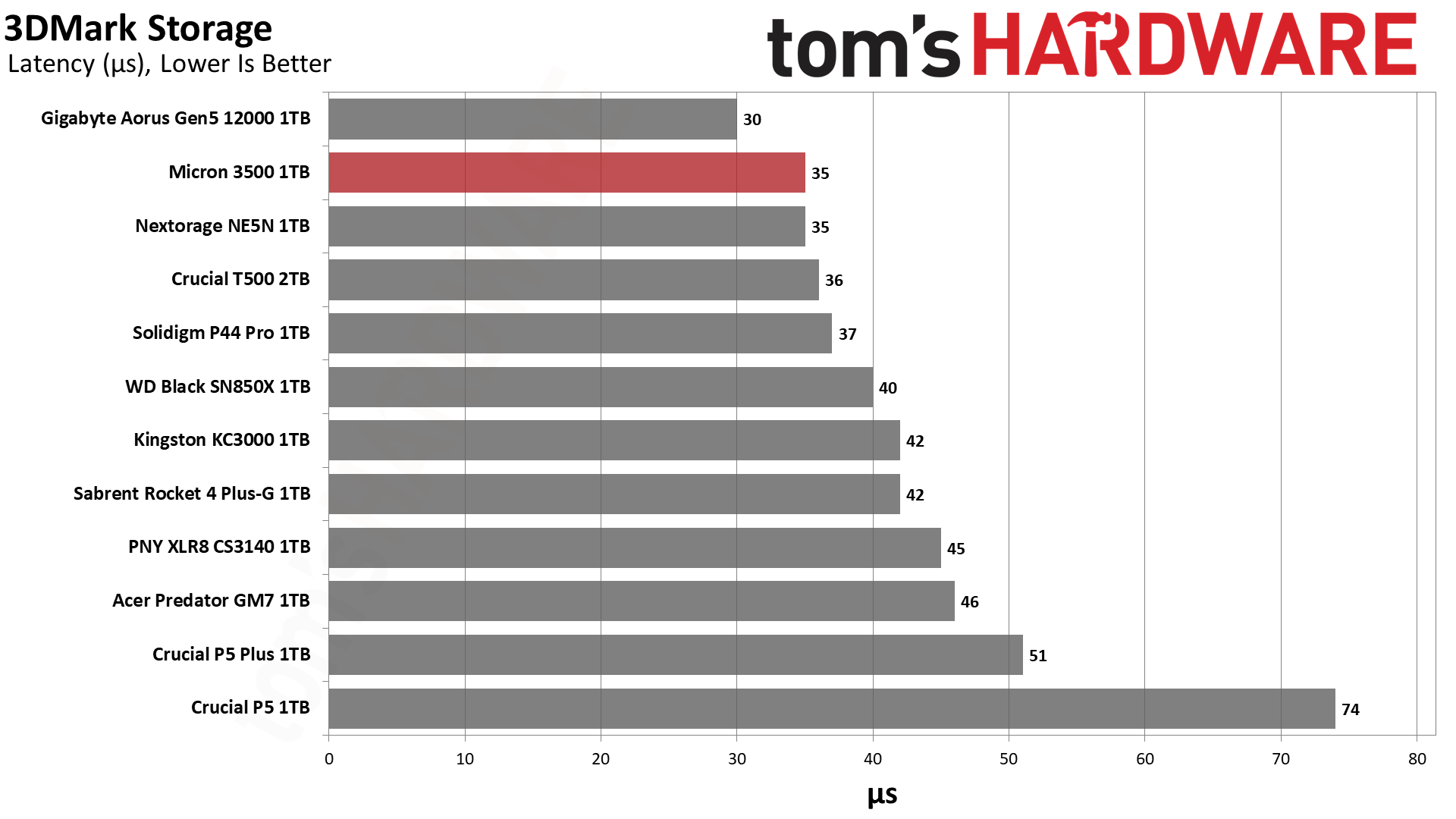


The Micron 3500 scores exceptionally well in 3DMark, only trailing the Aorus Gen5 12000. It should load games quite fast, even if the difference from slow drives is very small, and it's somewhat future-proof for upcoming game titles.
The 3500, like the T500, is DirectStorage-capable and Phison's firmware is optimized for the API. The 3500 has plenty of horsepower to get the most out of DirectStorage. While Micron does provide its own NVMe driver for Windows, the default one from Microsoft works just fine and is usually recommended.
Trace Testing — PCMark 10 Storage Benchmark
PCMark 10 is a trace-based benchmark that uses a wide-ranging set of real-world traces from popular applications and everyday tasks to measure the performance of storage devices.
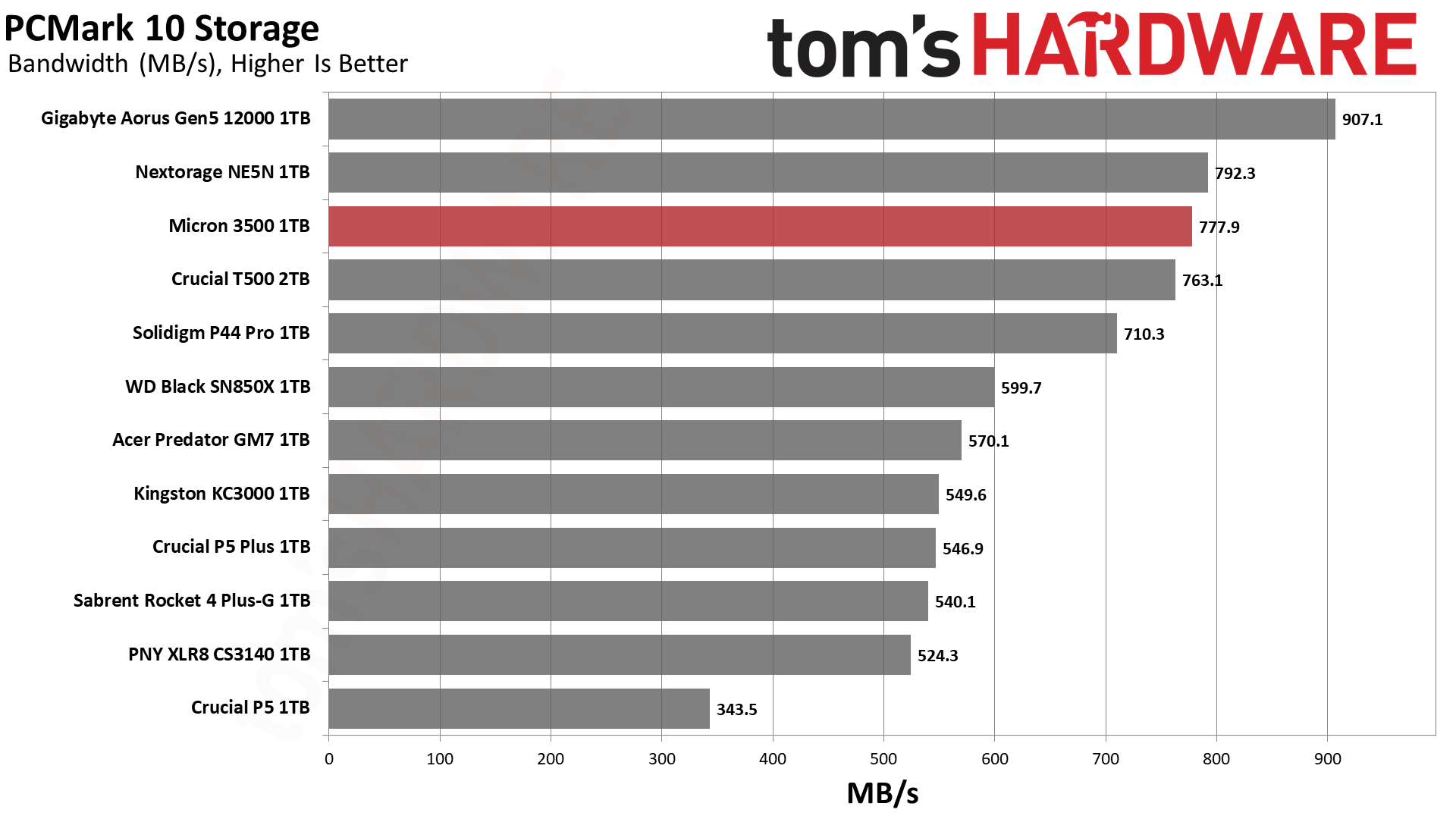
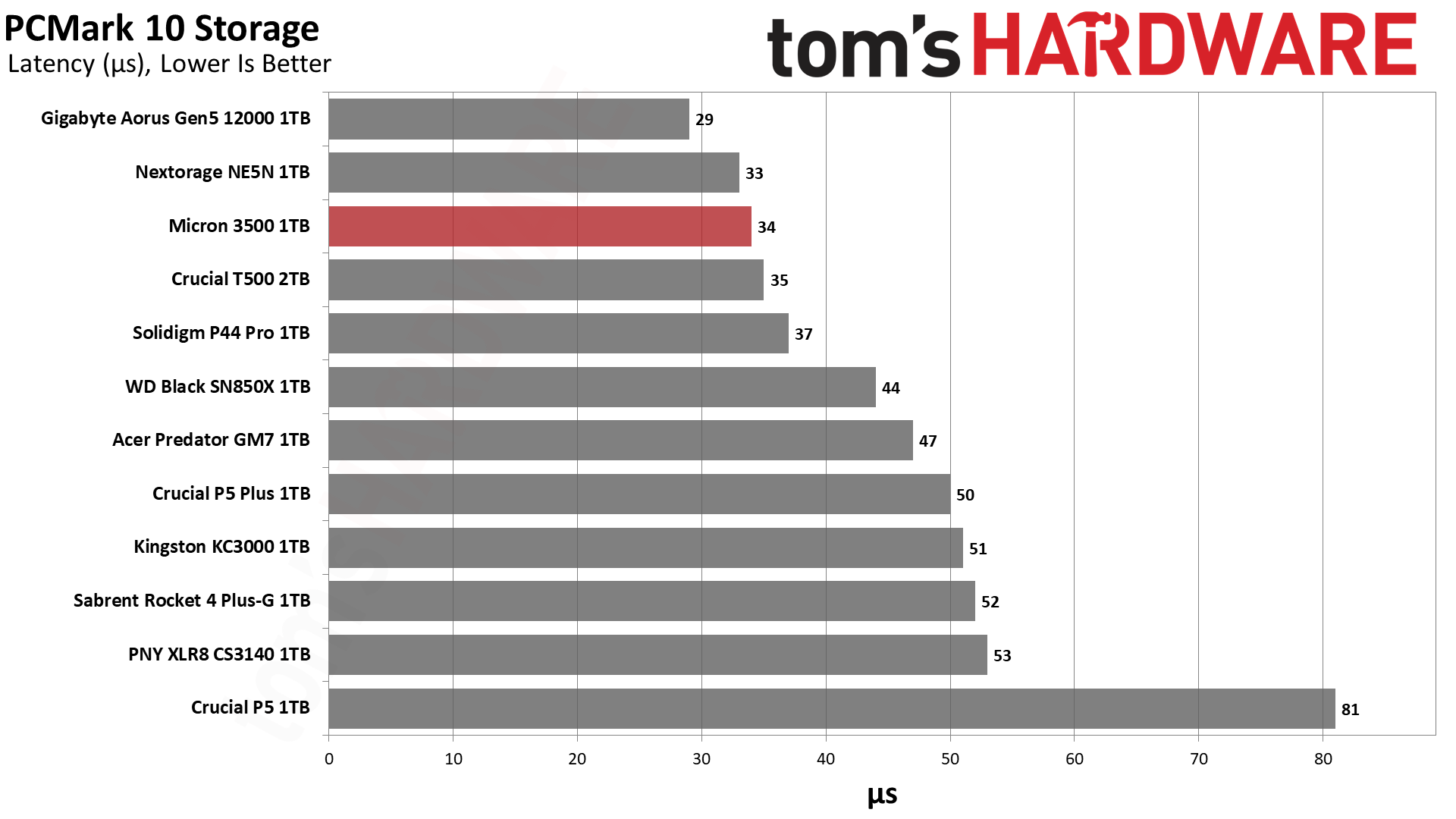
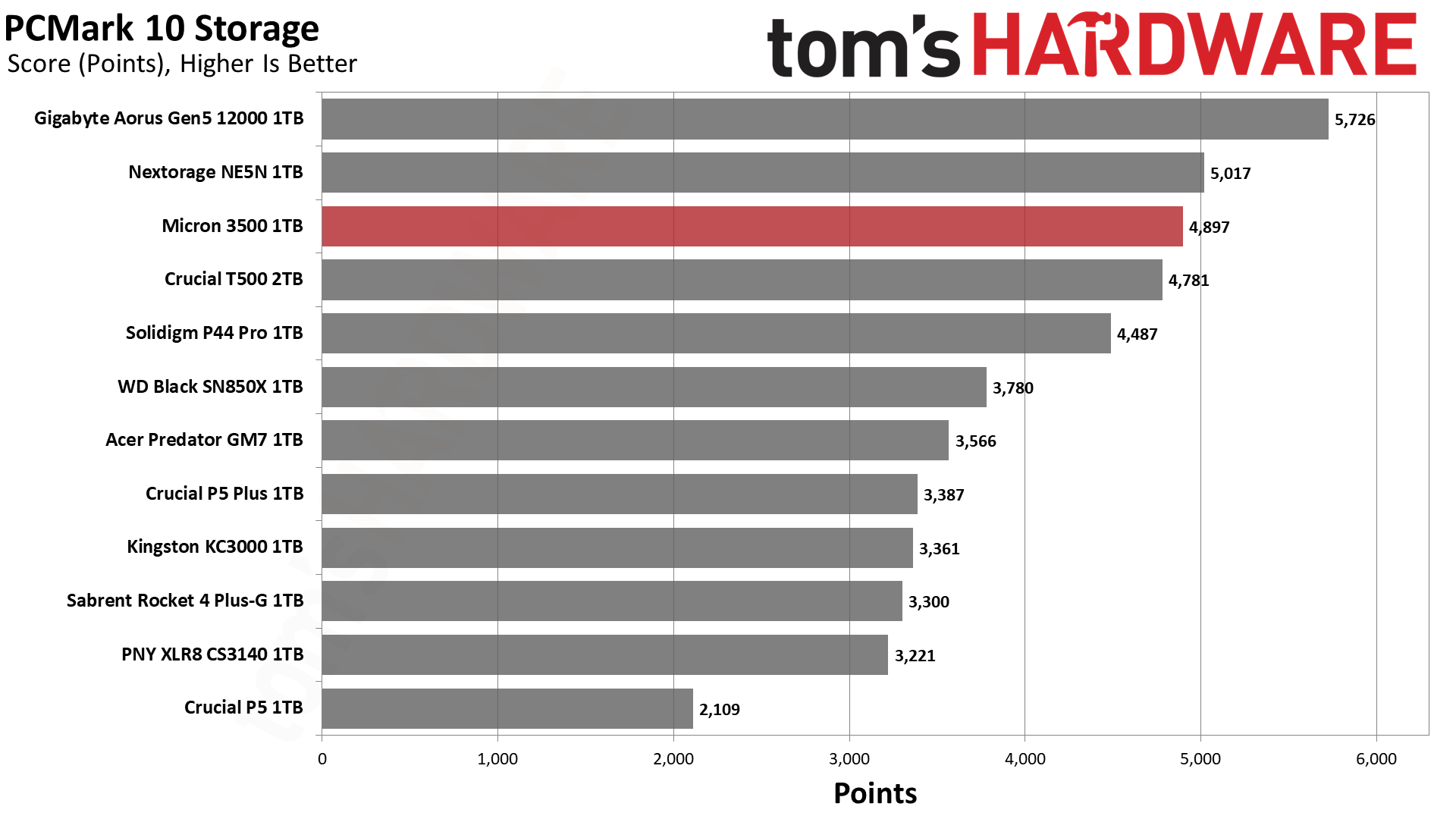
The Micron 3500 is fast in PCMark 10 as well, leading all the PCIe 4.0 drives, though PCIe 5.0 bandwidth enables the NE5N and Aorus 12000 to come out on top. The older P5 looks downright obsolete with its PCIe 3.0 interface.
PCMark is one area in which the 3500, and therefore the T500, beat the excellent P44 Pro and SN850X. The emphasis on burst performance with a new controller and flash — the latter of which has otherwise only been used for PCIe 5.0 solutions — allows the 3500 to demonstrate excellent application performance, which remains important in the client space.
Console Testing — PlayStation 5 Transfers
The PlayStation 5 is capable of taking one additional PCIe 4.0 or faster SSD for extra game storage, with certain 'requirements' (that aren't strictly enforced). The PS5 at launch could not use 8TB drives, but this limit has since been removed. While any PCIe 4.0 drive will work, Sony specifies that drives that deliver at least 5,500 MB/s of sequential read bandwidth are optimal.
The PS5 does not support the host memory buffer (HMB) feature, but DRAM-less drives will still work — as will slower PCIe 3.0 drives. In our testing, PCIe 5.0 SSDs performed irregularly and should not be used in the PS5, especially as they may require additional cooling. Please see our Best PS5 SSDs article for more information.
Our testing utilizes the PS5's internal storage test and manual read/write tests with over 192GB of data, moving game files both from and to the internal storage. Throttling is prevented where possible via the use of the very convenient Sabrent PS5 heatsink cover.
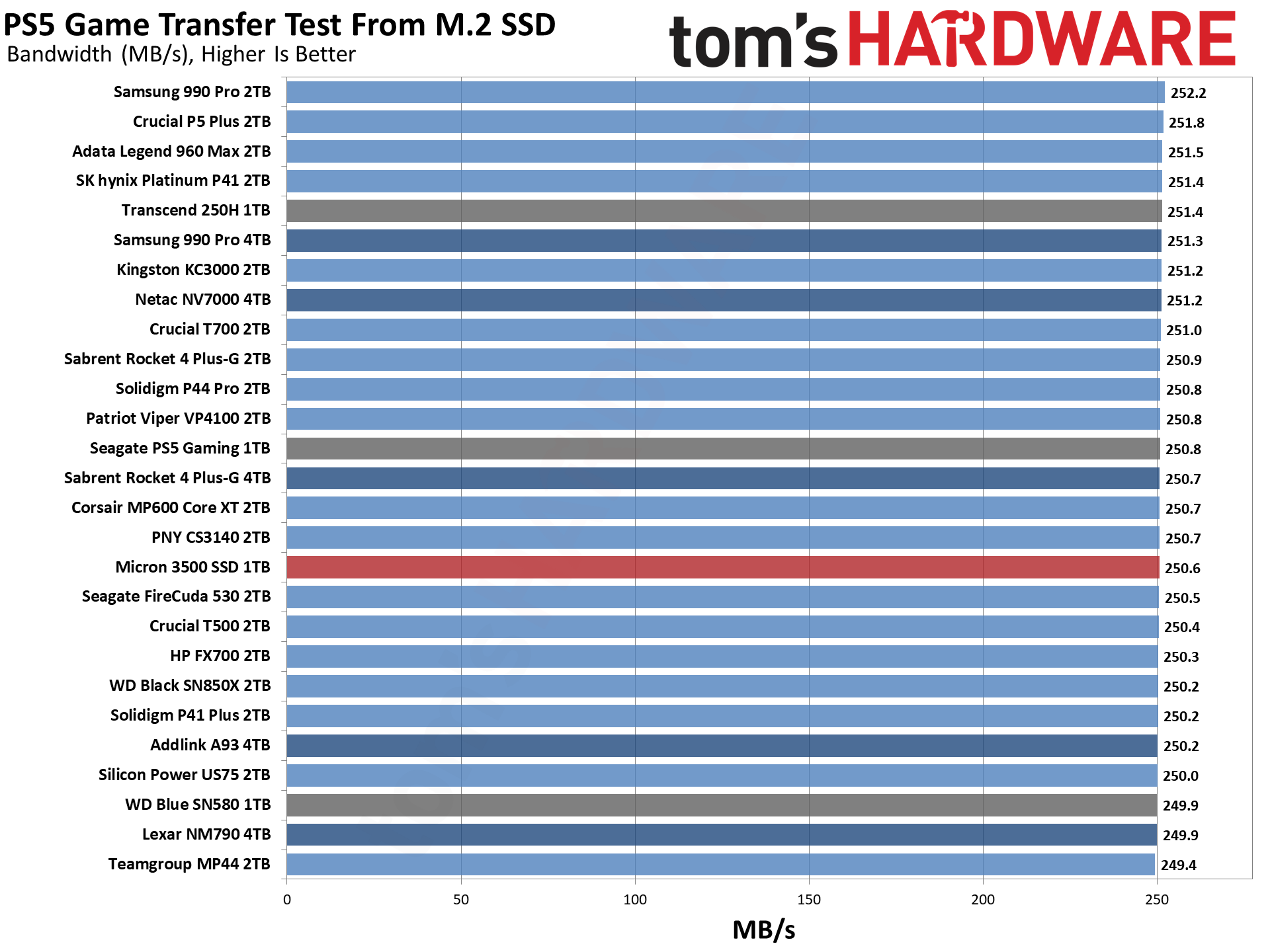
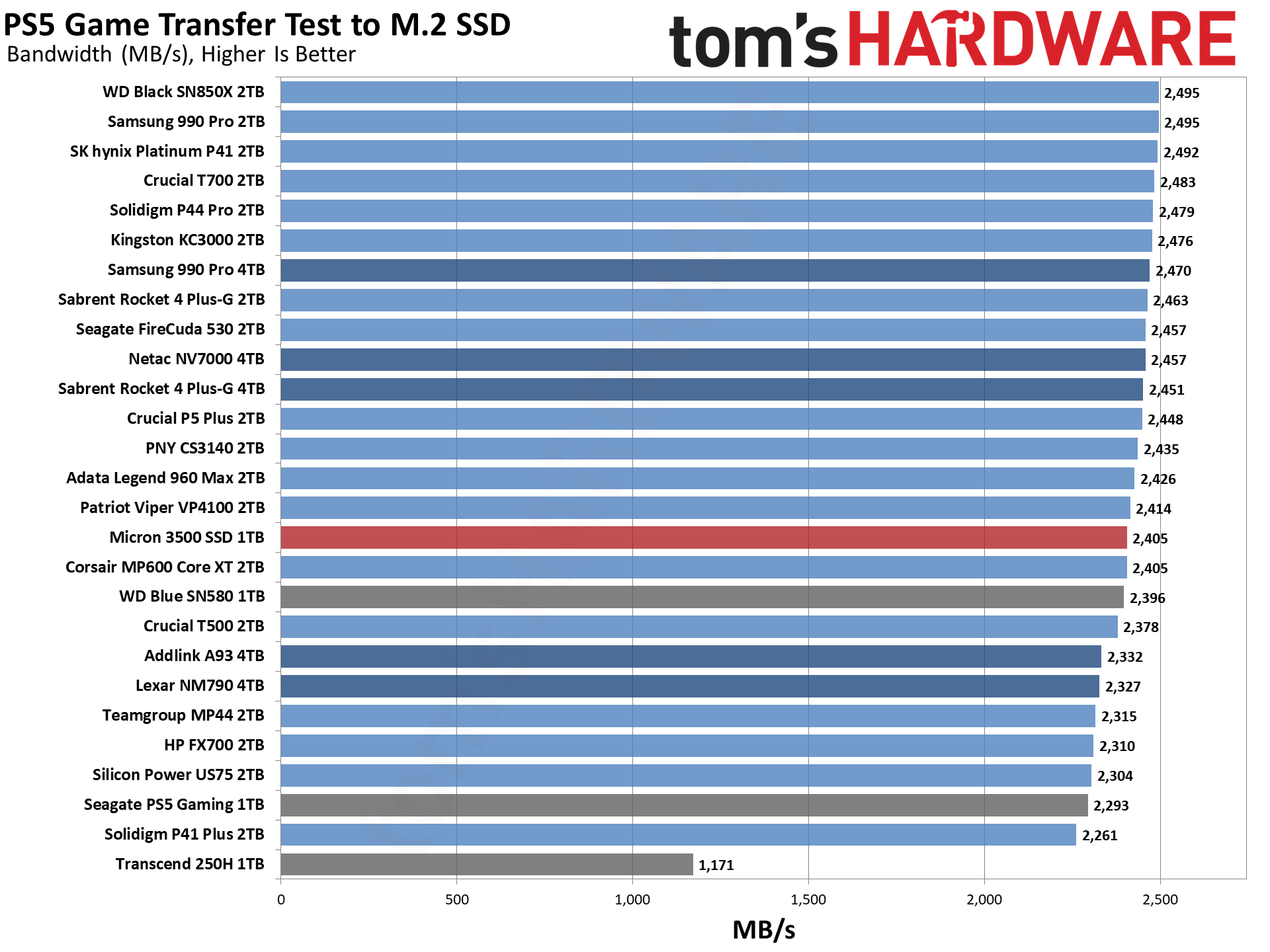
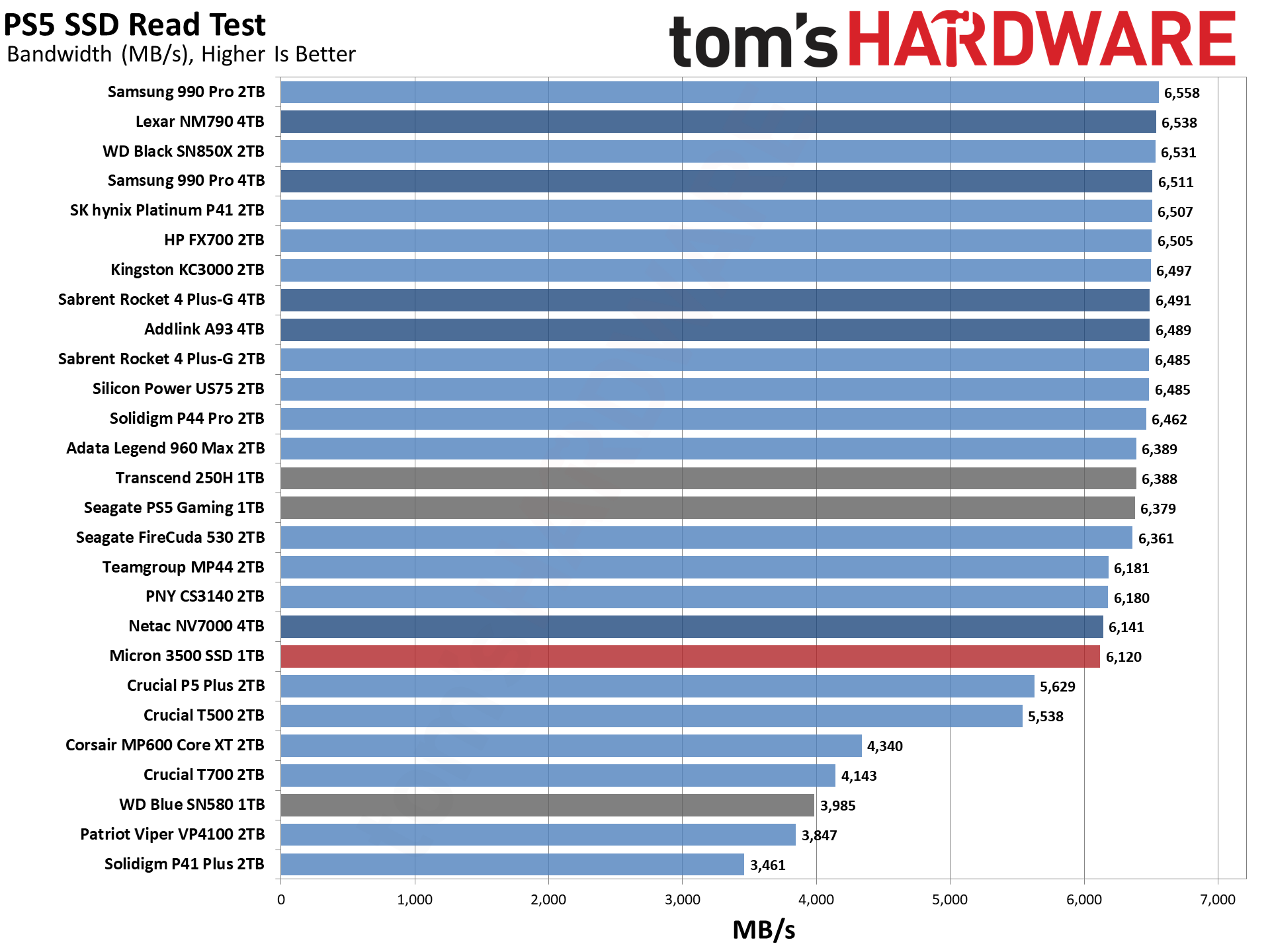
The PlayStation 5 results for the Crucial T500 and Micron 3500 do exhibit some anomalies. The benchmark results for these drives changed with PS5 updates. This is something Crucial stated it was investigating with the T500, but that it poses no performance issues for the console. This is a valid claim as the default benchmark is known to be squirrely, and we got a better read score with the 3500, which suggests some firmware optimization has already taken place.
Get Tom's Hardware's best news and in-depth reviews, straight to your inbox.
Transfer Rates — DiskBench
We use the DiskBench storage benchmarking tool to test file transfer performance with a custom, 50GB dataset. We copy 31,227 files of various types, such as pictures, PDFs, and videos to a new folder and then follow-up with a reading test of a newly-written 6.5GB zip file. Note that the source drive for the write test is a PCIe 4.0 SSD, which can potentially bottleneck performance on PCIe 5.0 drives.
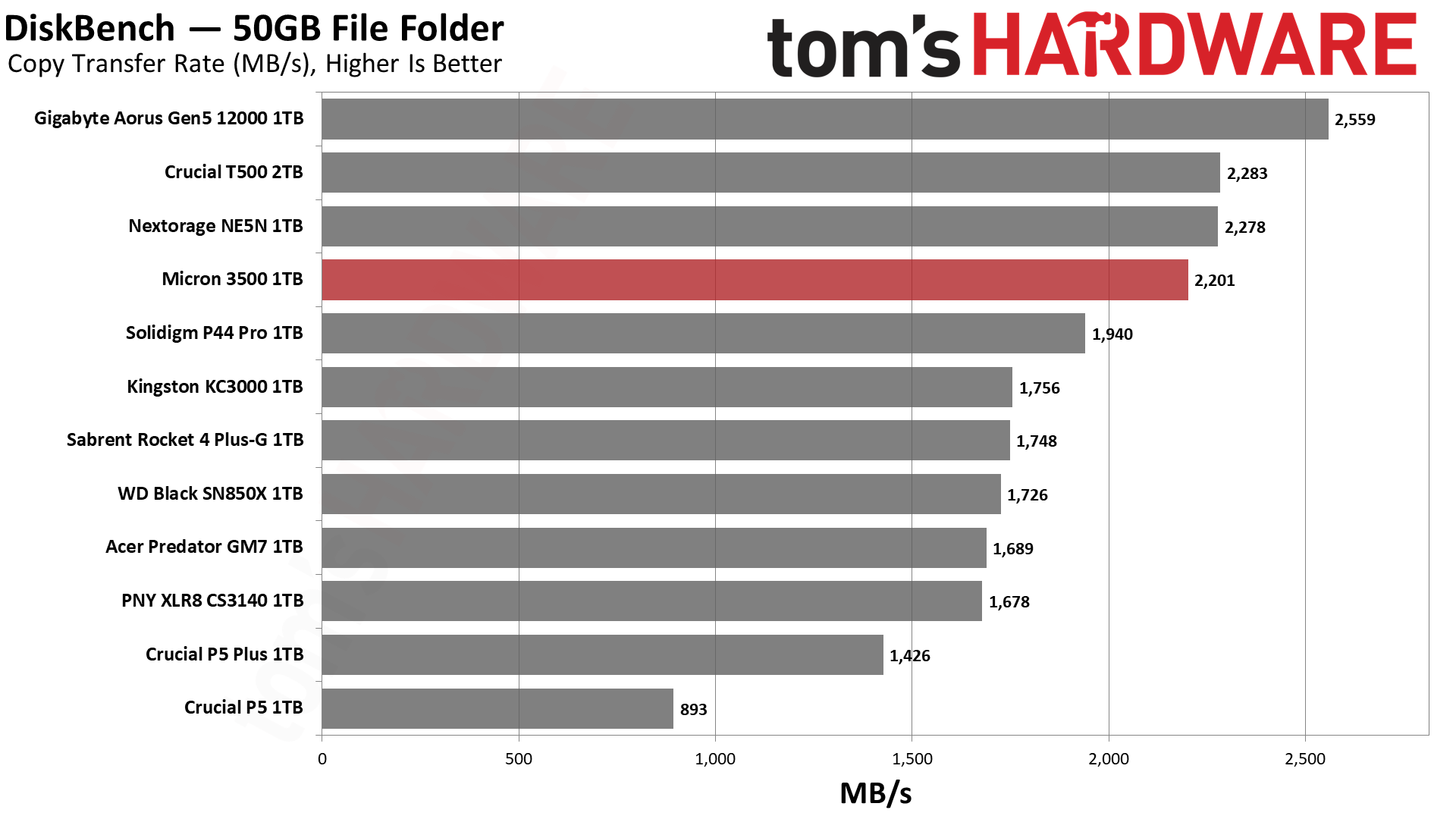
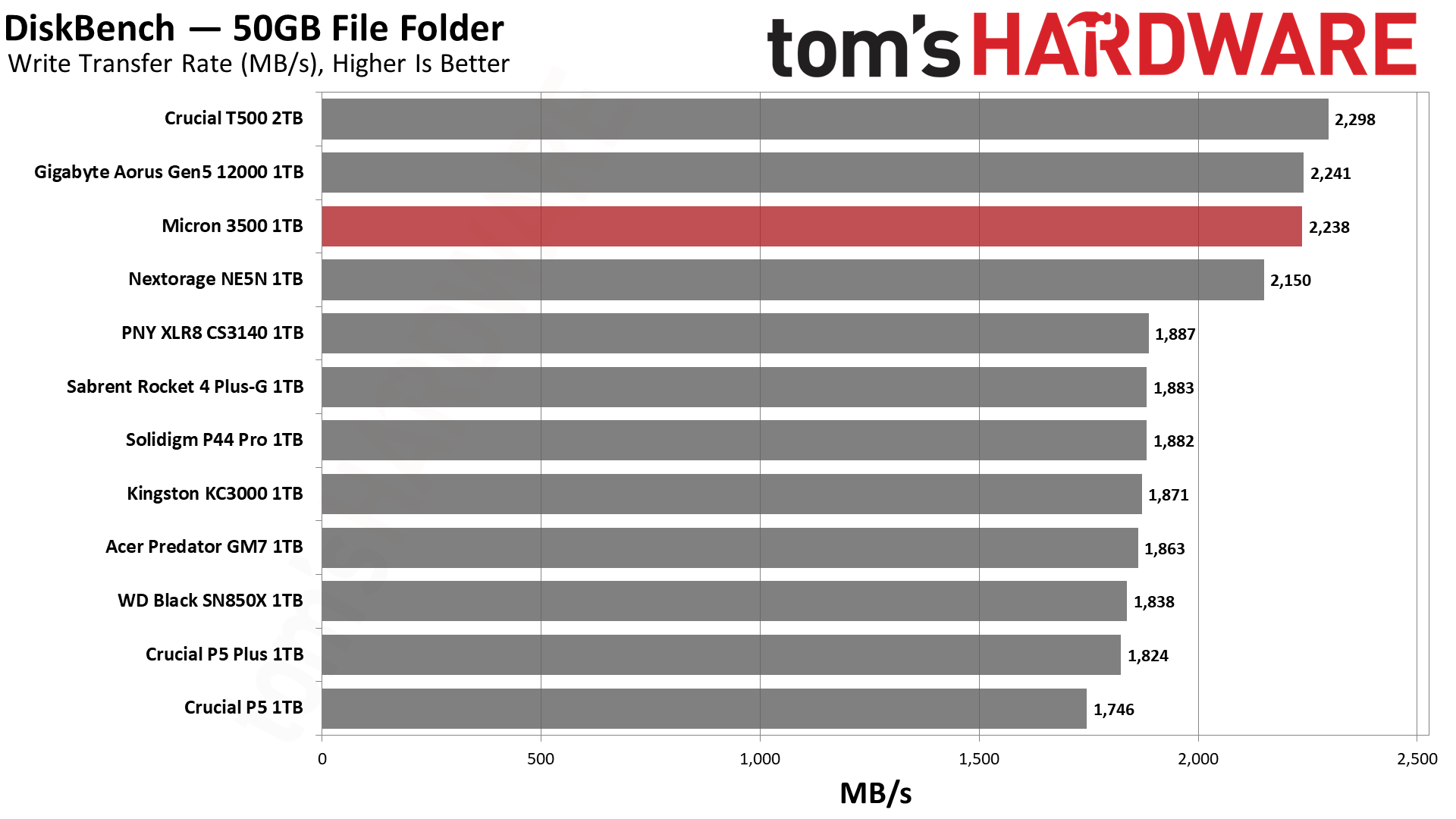
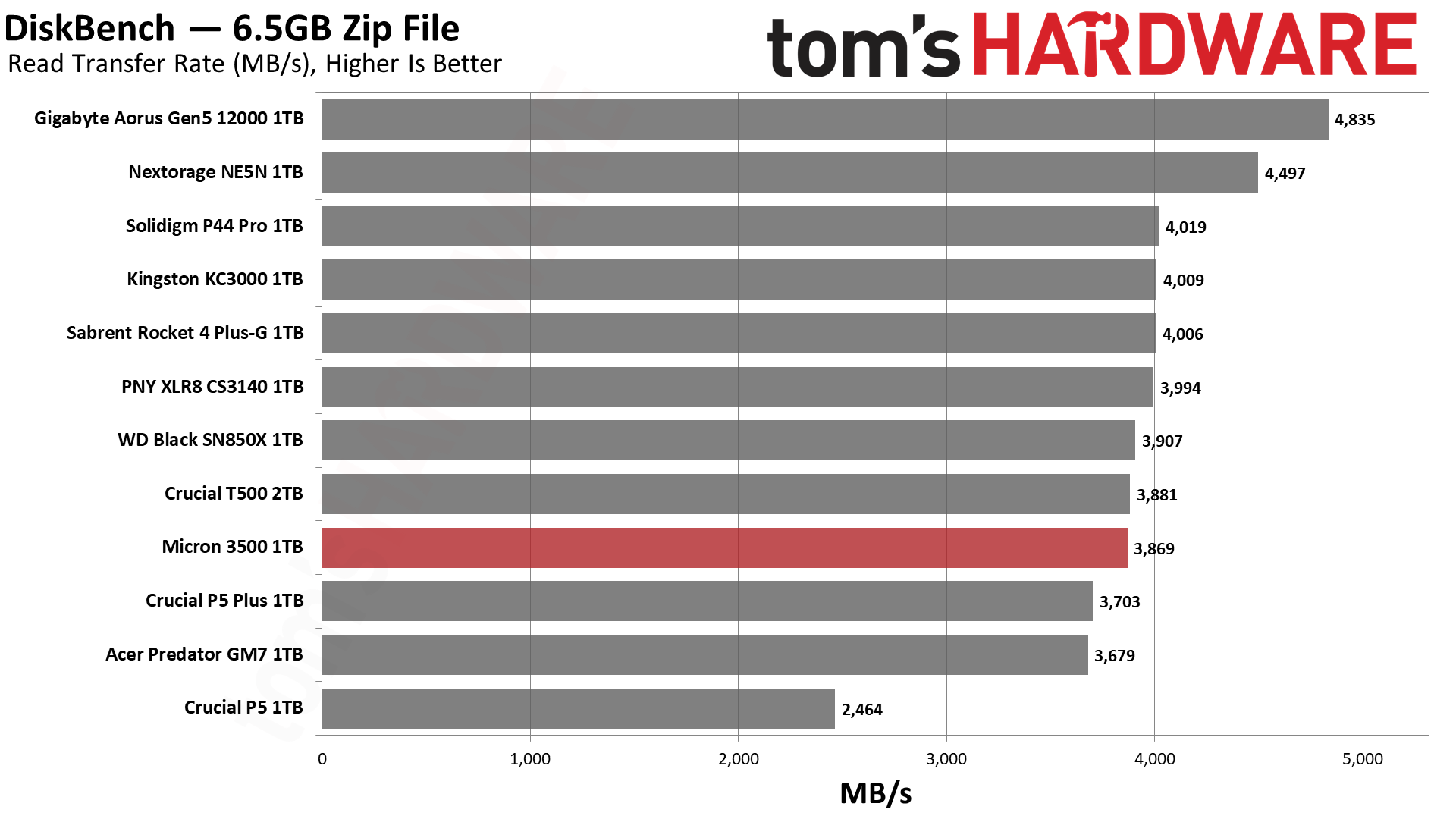
At 2.2 GB/s, the Micron 3500's copy transfer rate is quite good. It beats all of the PCIe 4.0 flock but struggles against proper PCIe 5.0 drives like the Crucial T700. The 2TB T500 also scores a little higher than the 3500, possibly due to it having more flash that allows it to eke out a little bit more peak write performance. It's worth looking at the fastest PCIe 5.0 drives if transfer performance is important to you, but PCIe 4.0 drives are generally fast enough.
Synthetic Testing — ATTO / CrystalDiskMark
ATTO and CrystalDiskMark (CDM) are free and easy-to-use storage benchmarking tools that SSD vendors commonly use to assign performance specifications to their products. Both of these tools give us insight into how each device handles different file sizes.
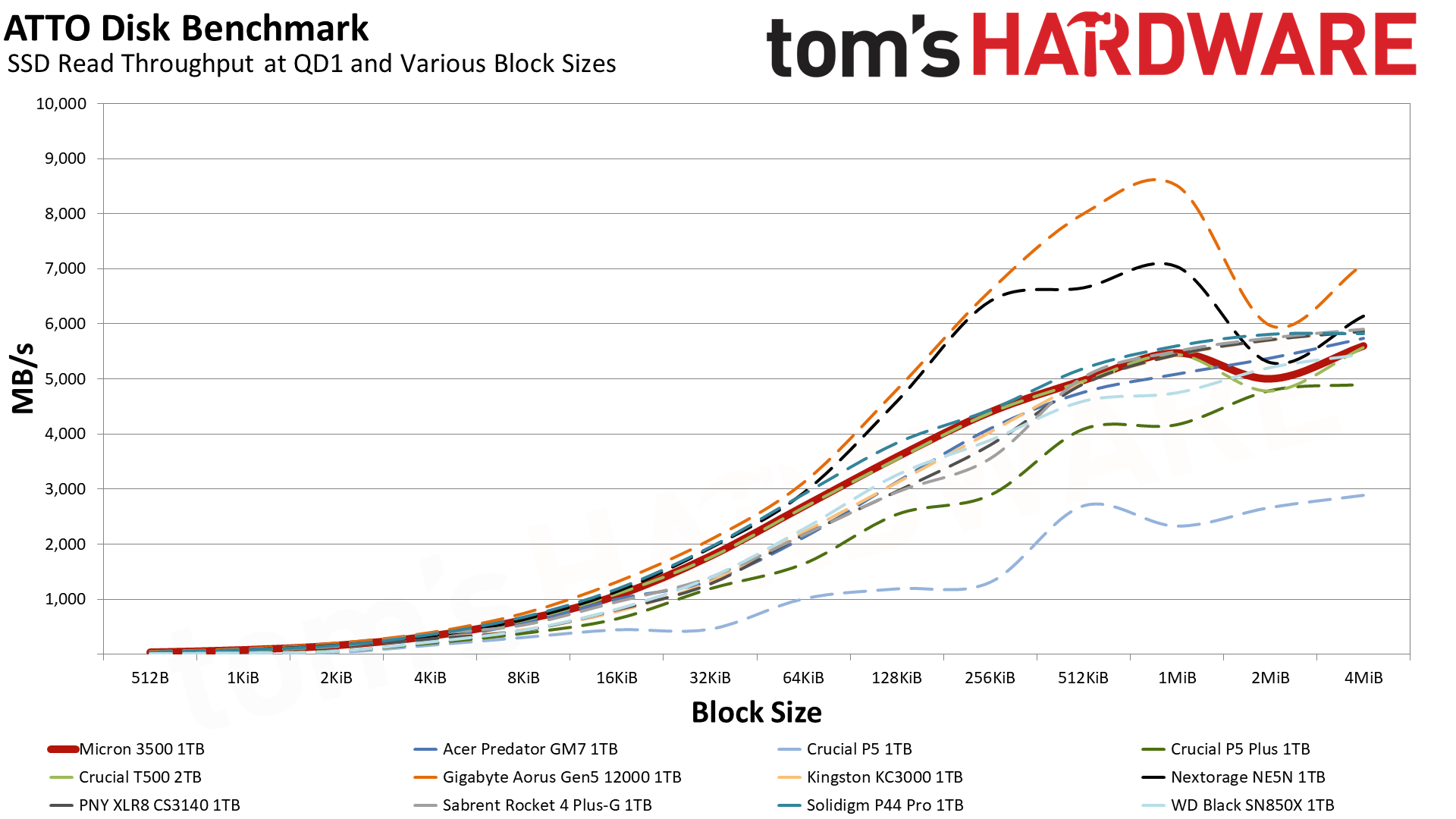

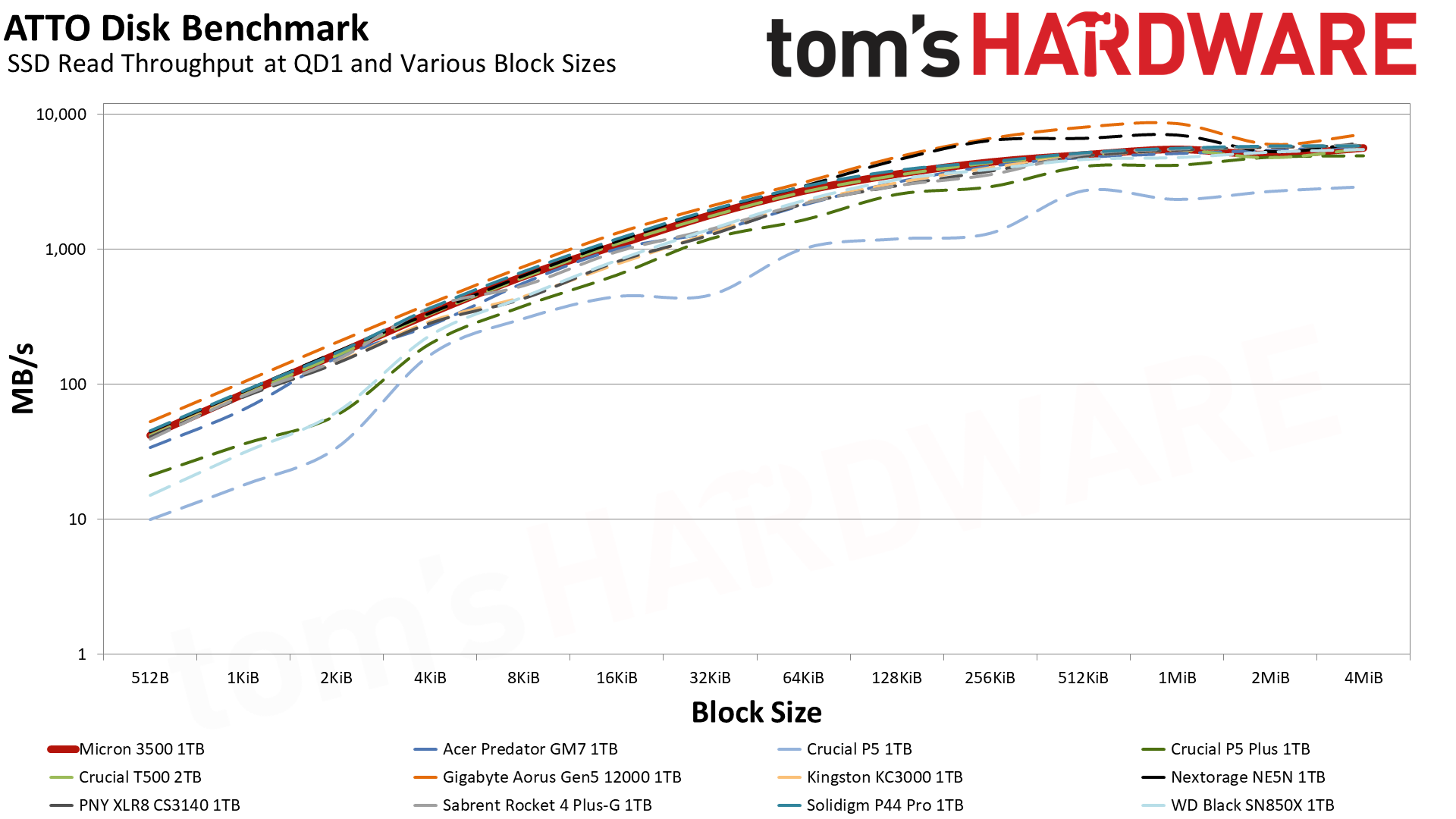


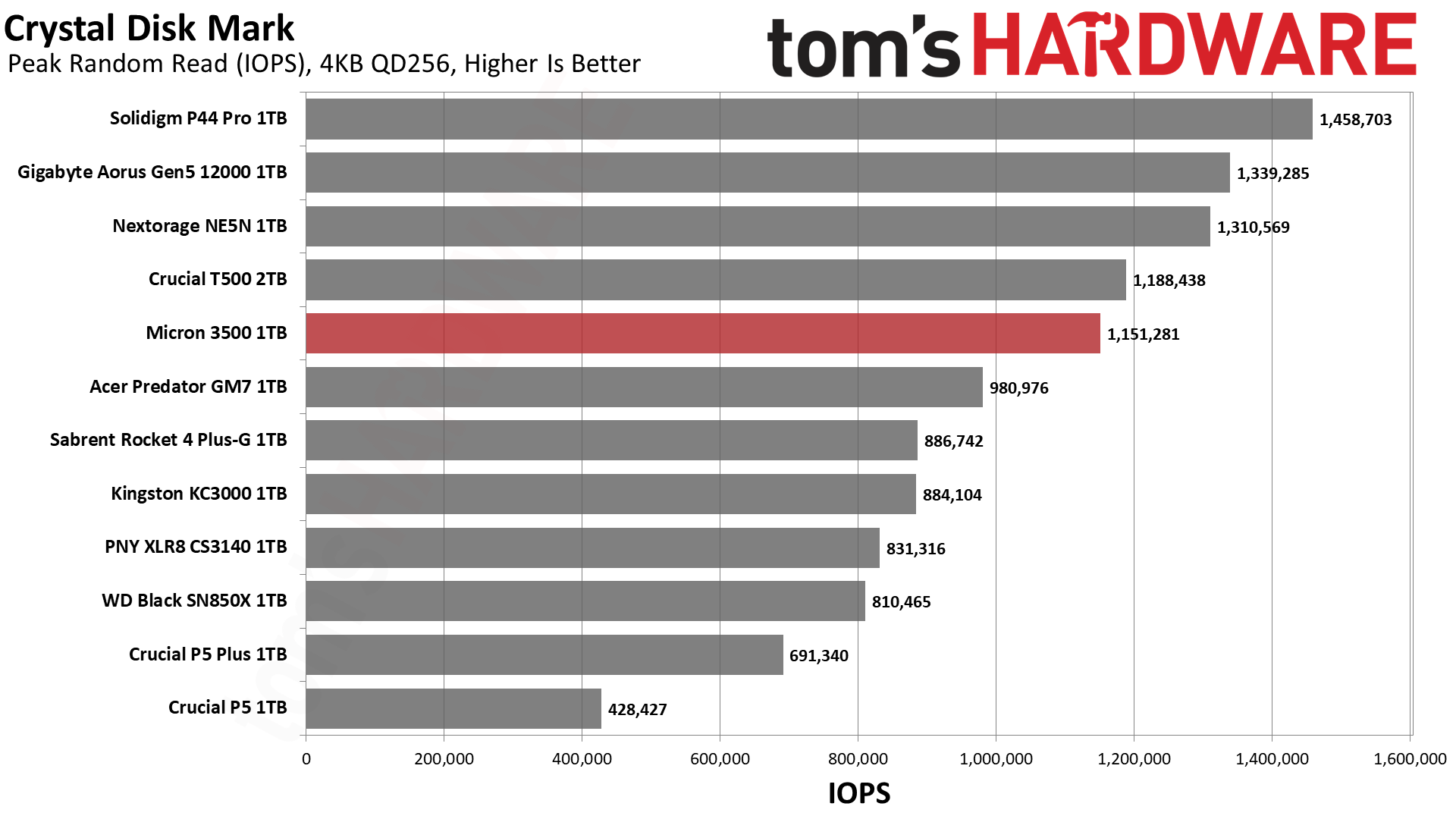
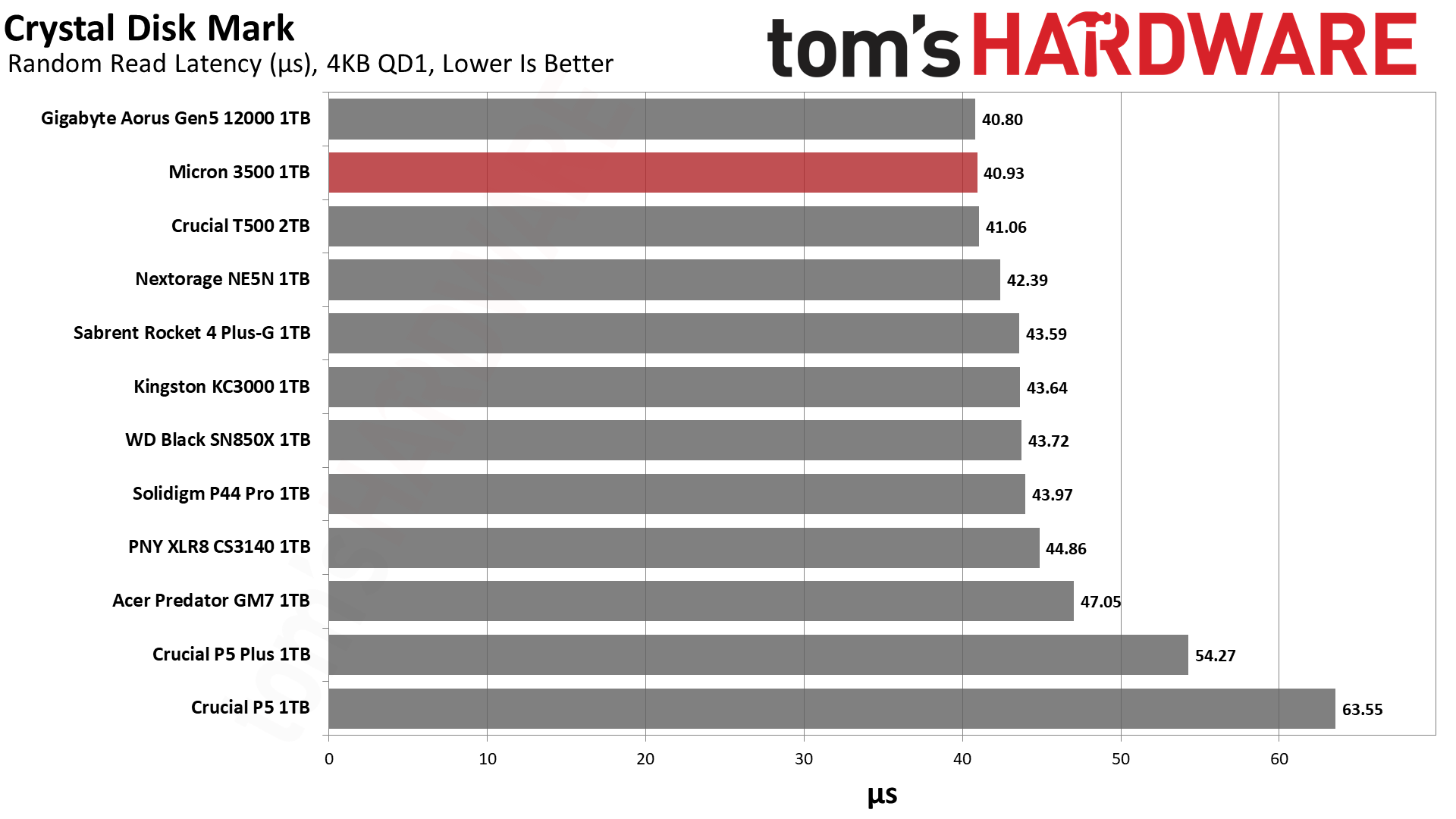
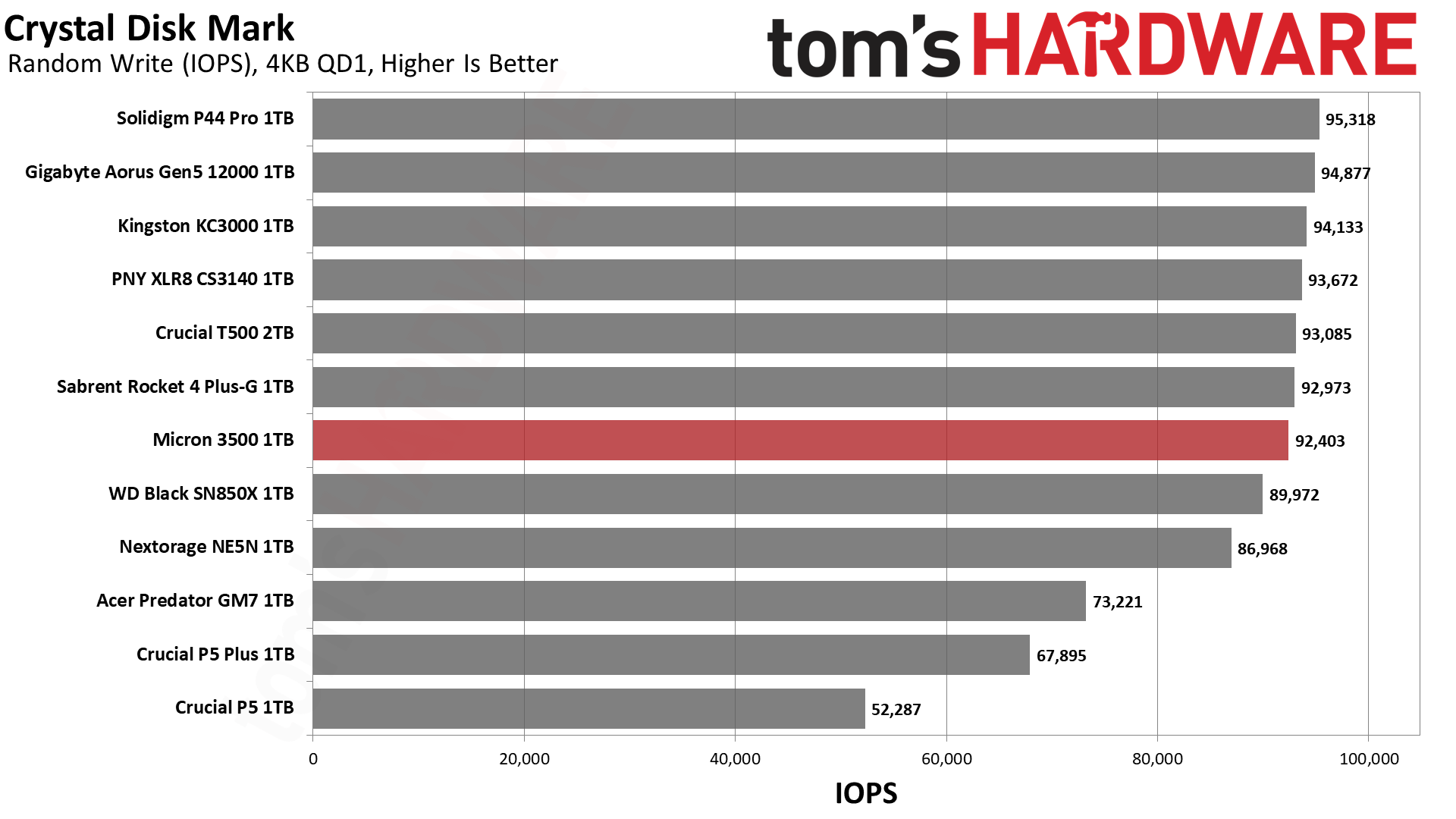
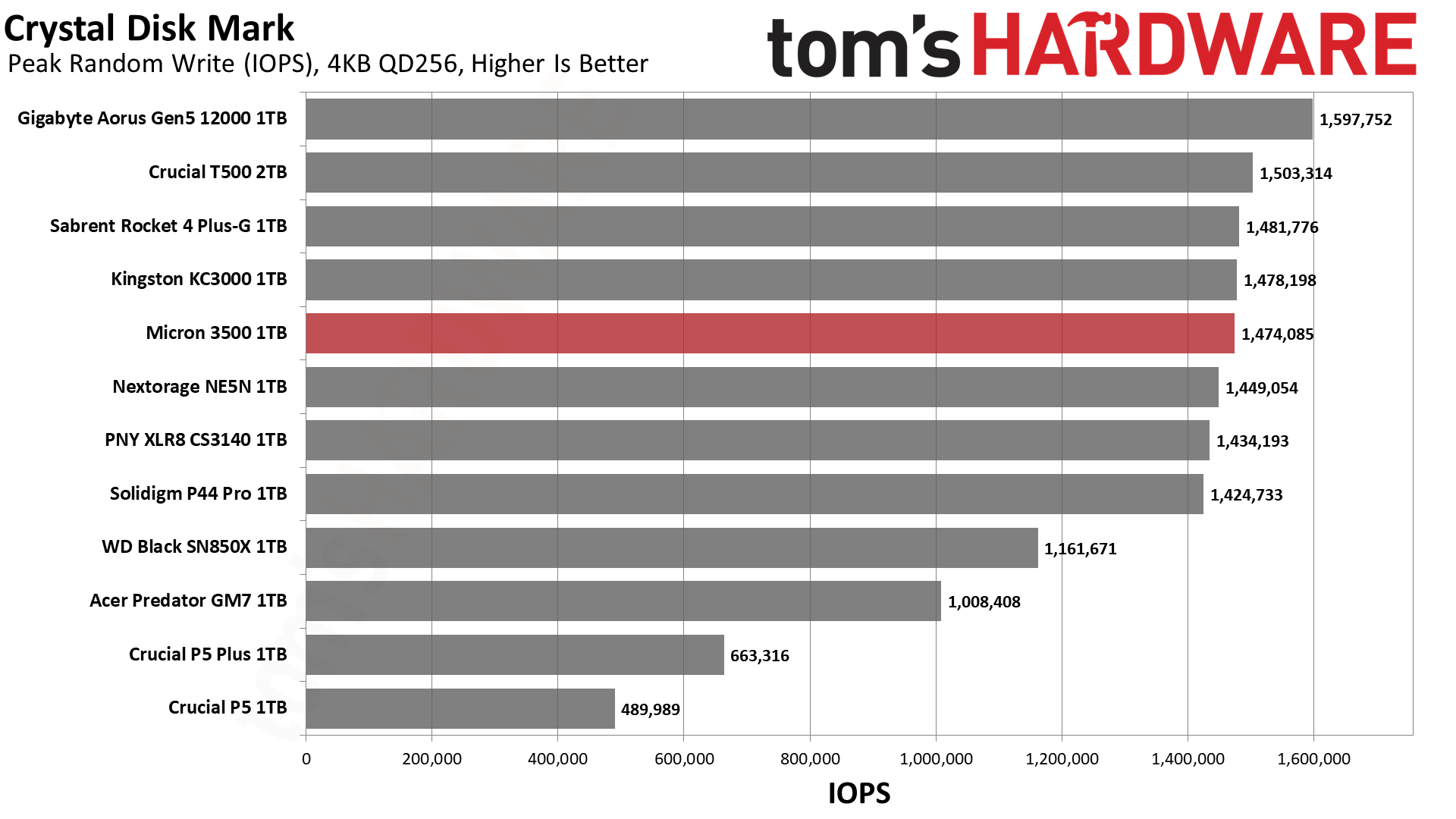
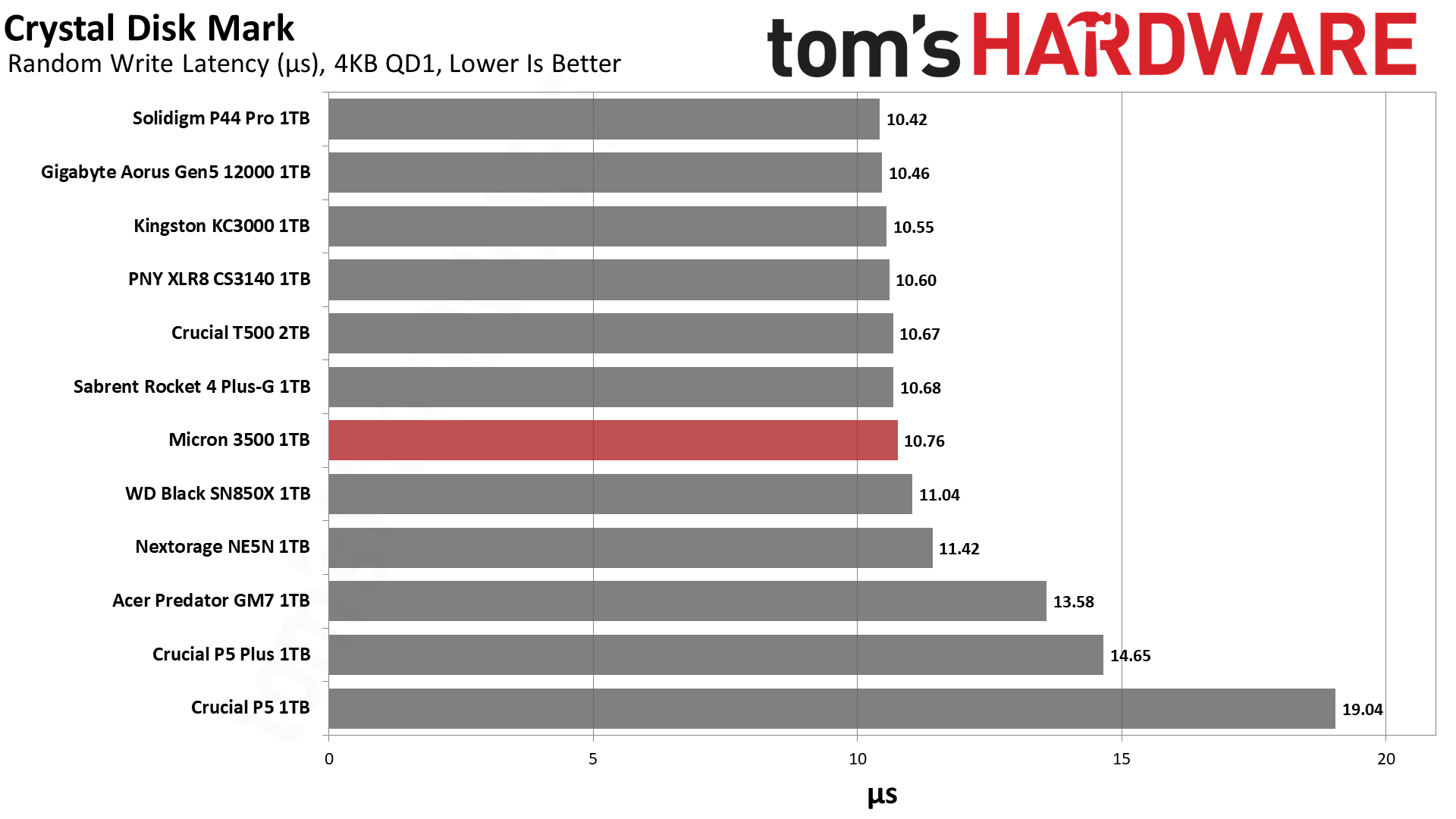
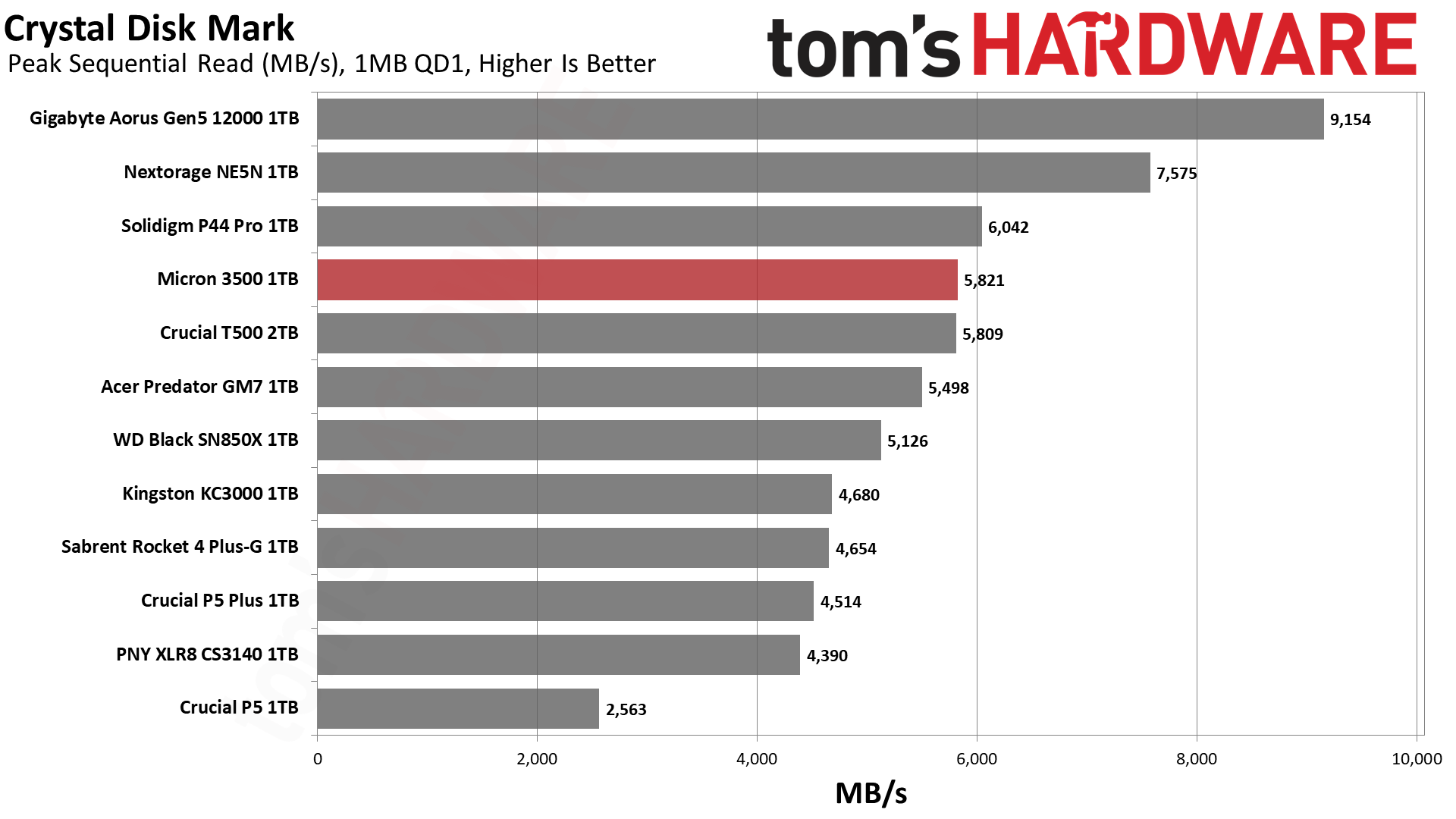
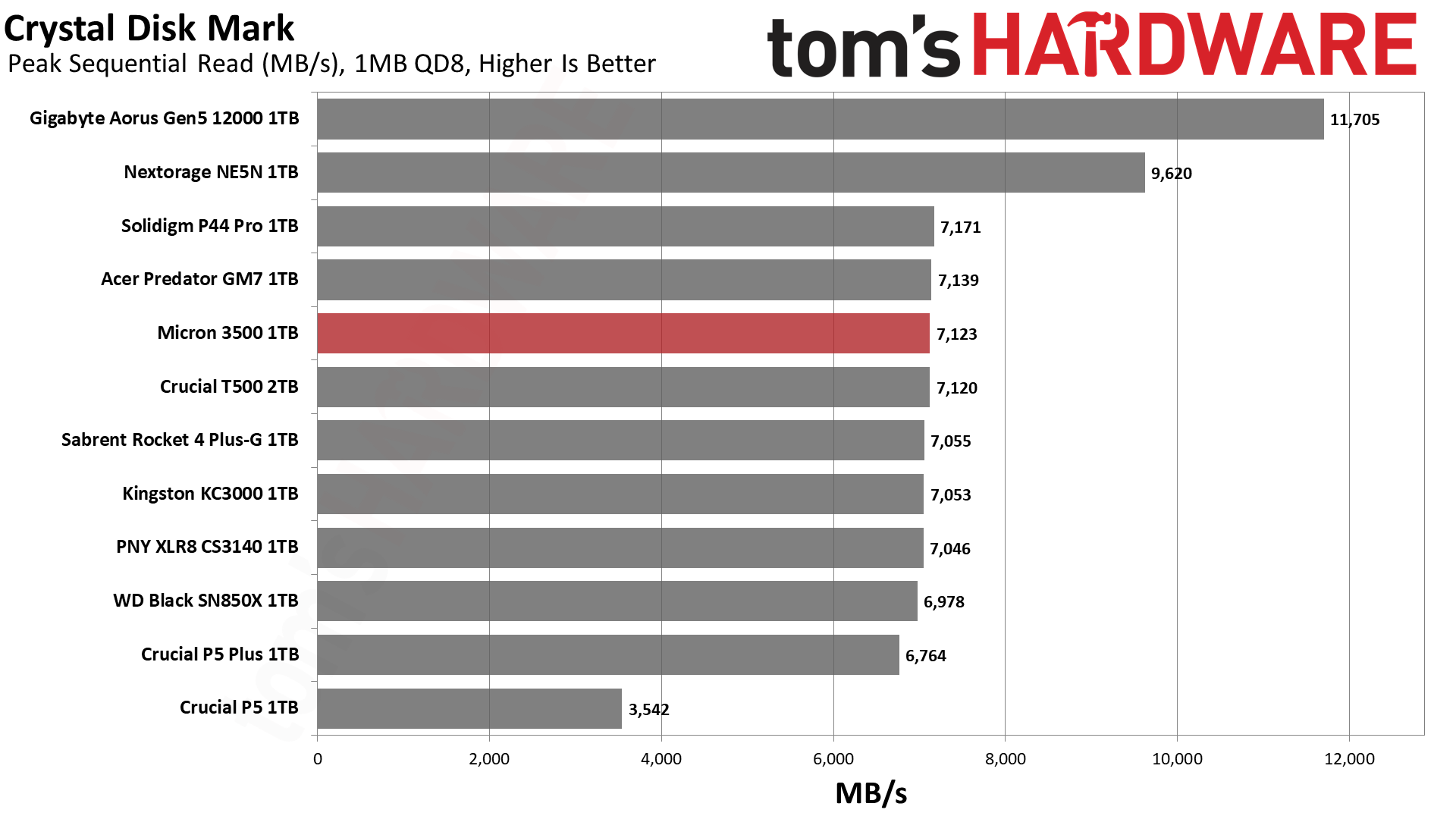
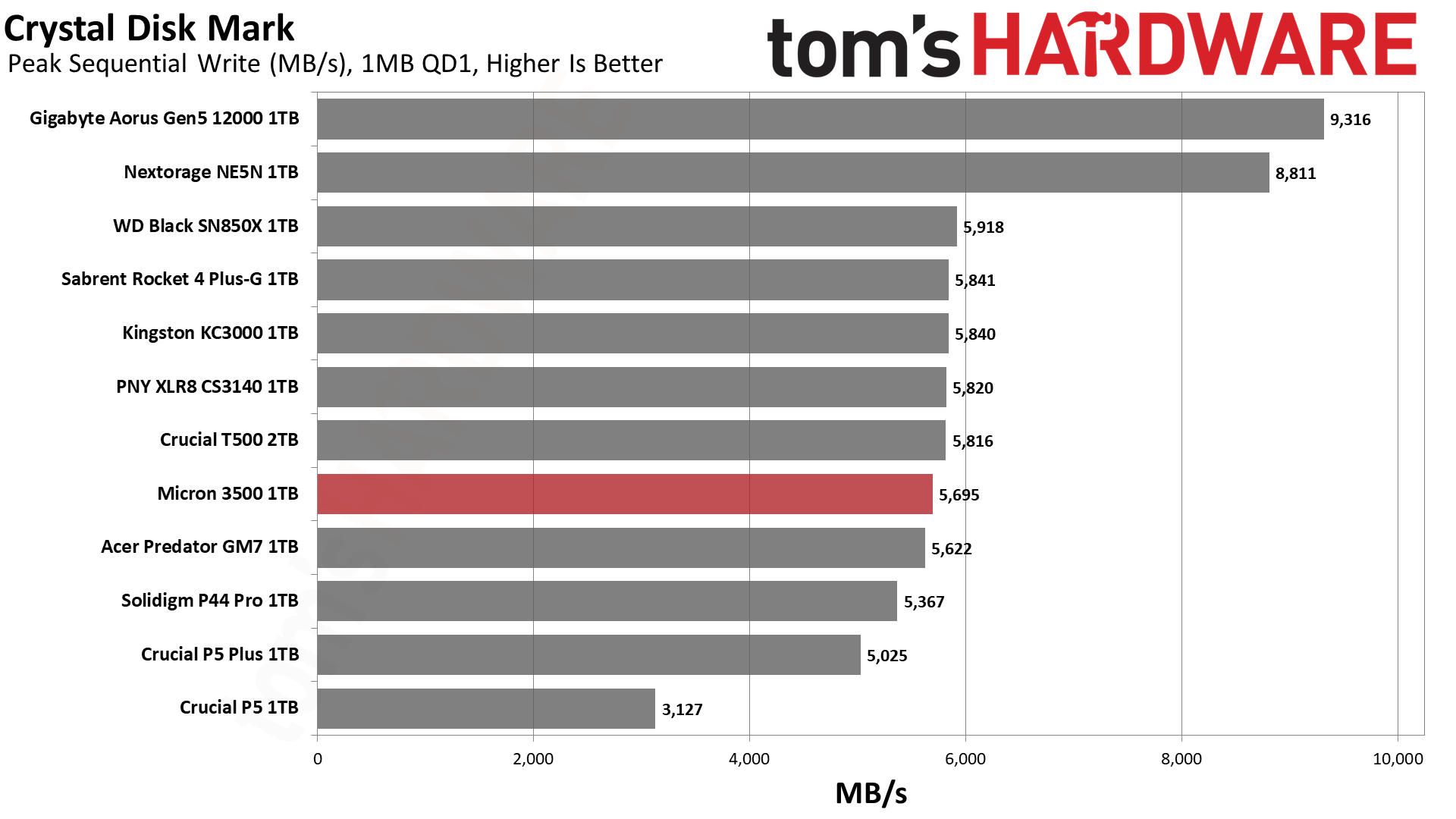

The Micron 3500 produces mostly smooth curves in ATTO, sharing the valley with the T500 in sequential reads around the 2MiB block size. The PCIe 5.0 drives are both faster thanks to their PCIe 5.0 interface. Looking more closely at small block sizes, we do see large dips with the PCIe 5.0 E26 in the 512KiB-2KiB write range. The 3500 and T500 also dip between 1KiB and 2KiB.
Consumer SSDs tend to be optimized around 4KiB performance, with smaller I/O potentially requiring more memory overhead to manage for optimal placement. The 4K LDPC on the 3500, T500, Aorus 12000, and NE5N may be related to these performance anomalies, as is the fact we often see an abundance of DRAM for these newer Phison controllers.
Improved ECC can improve read latency, which might be why we see good things from Micron's 232-Layer TLC with these Phison controllers. Raising the I/O rate can also help with latency and may be why the Micron 3500 and Crucial T500 outperform the NE5N in 4KB QD1 writes. Nothing touches the launch Samsung 990 Pro in terms of read latency, but that advantage has probably vanished with Samsung migrating to its newest flash generation for the 990 Pro. That new flash brings no 4KB performance gains and in fact is rated to be a little bit slower. Sequential performance for the 3500 in CDM is good and at the limits of PCIe 4.0.
Micron officially lists the 3500 as having a typical read latency of 50µs and a write latency of 12µs. This compares to 54µs and 14µs for the older 3400. These numbers are for typical, or median, 4KiB QD1 and it's important not to misinterpret the write latency — writes can be cached in volatile memory and four 4KB segments fit into one 16KB page. Micron uses a queue depth of 32 for its sequential measurements and 128 for random 4KB, so if you're testing your drive be sure to align the benchmarking software. Micron uses the flexible I/O (FIO) tester for its rated results if you want to precisely test, but keep in mind this must be done on a fresh drive for accuracy. Performance will vary by platform.
Sustained Write Performance and Cache Recovery
Official write specifications are only part of the performance picture. Most SSDs implement a write cache, which is a fast area of (usually) pseudo-SLC programmed flash that absorbs incoming data. Sustained write speeds can suffer tremendously once the workload spills outside of the cache and into the "native" TLC or QLC flash.
We use Iometer to hammer the SSD with sequential writes for 15 minutes or more (we tested the T700 4TB for two hours of sustained writes) to measure both the size of the write cache and performance after the cache is saturated. We also monitor cache recovery via multiple idle rounds.
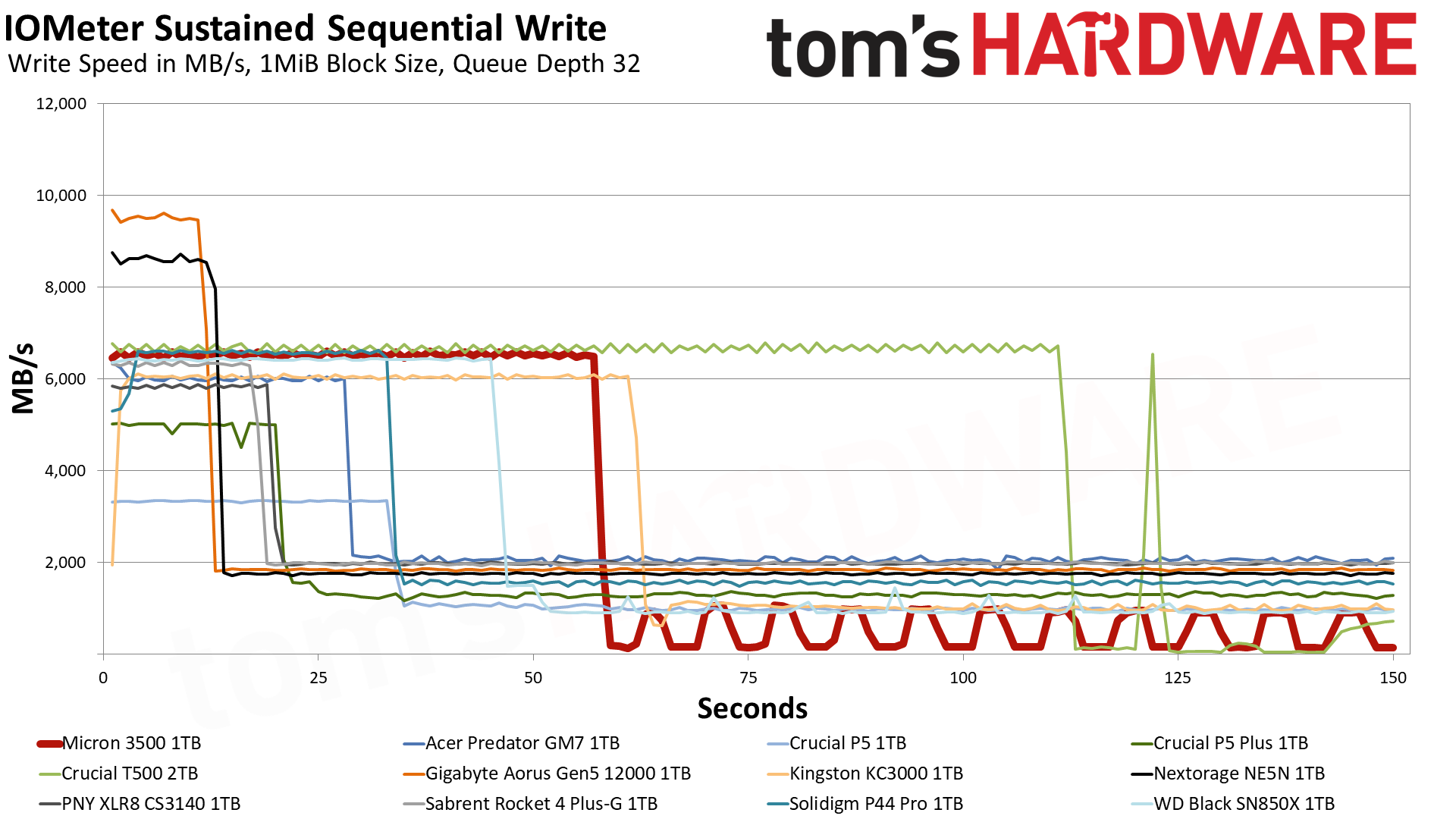
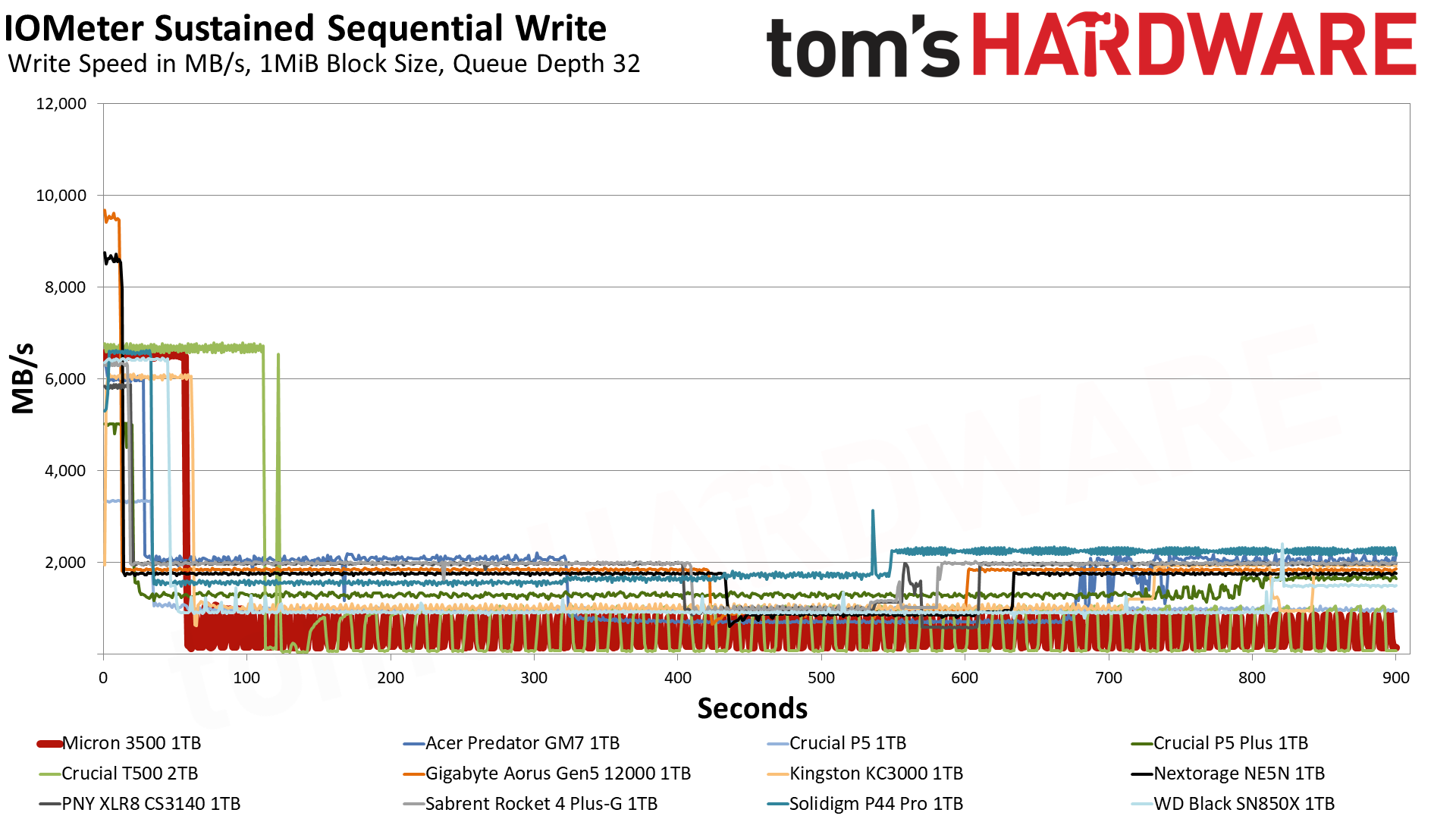
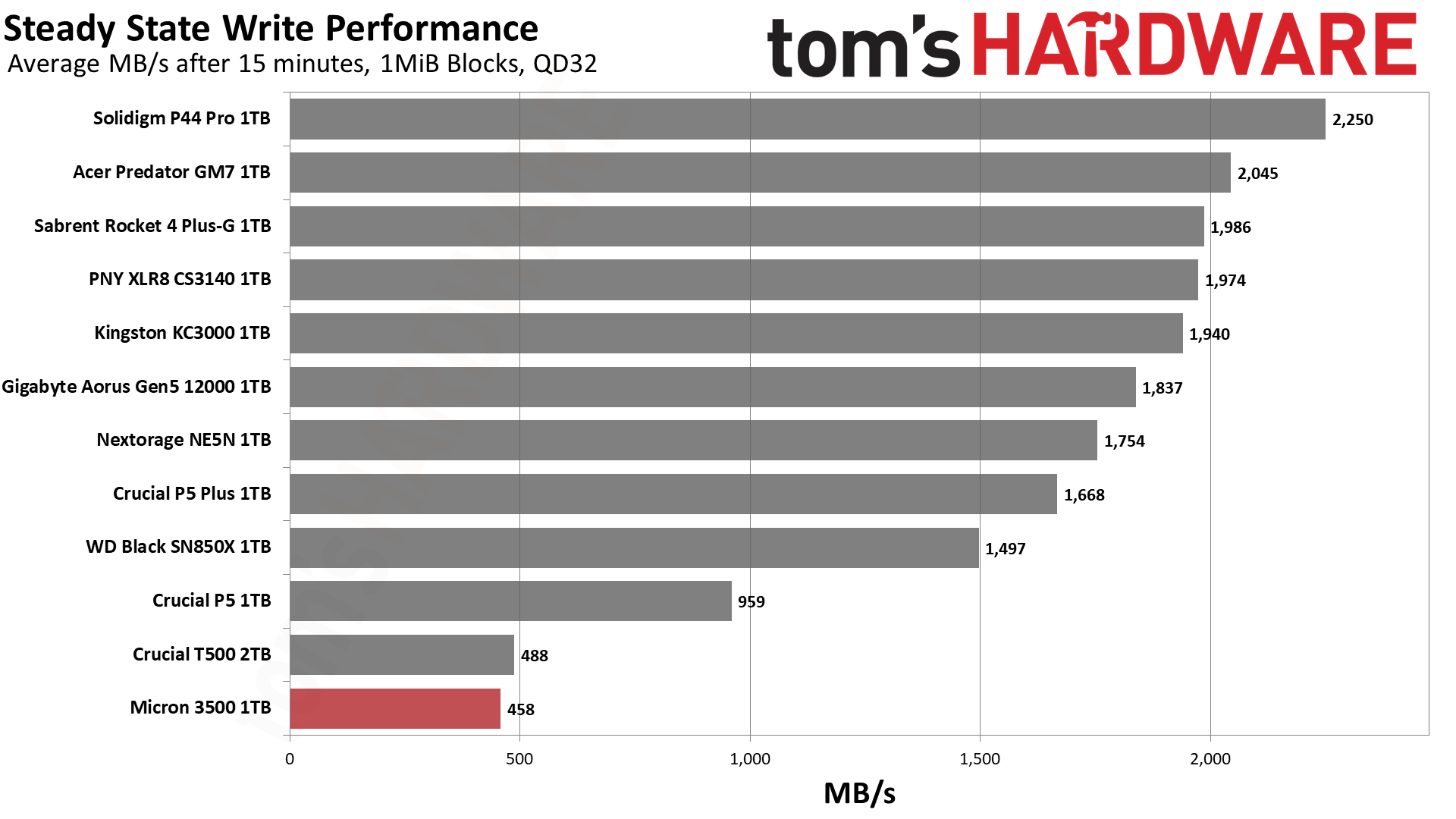
The 1TB Micron 3500 writes at an average of 6.5 GB/s for 57 seconds in pSLC mode. This suggests a cache of 372GB that, considering the actual flash amount and decimal to binary conversion, means effectively all of the TLC engaged for pSLC write caching. The drive then hits a folding state where it clears out the cache, causing it to ping-pong between ~150 and ~850 MB/s for a steady state average of around 500 MB/s — in other words, a chunk of the pSLC cache gets reallocated back as TLC, one third of which then gets filled with the existing data while the remaining two thirds can take new data. And this all happens while new writes continue to pepper the drive.
What you don't see in the above line charts is that the Micron 3500 eventually recovers from the folding state after about 1,400 seconds and starts writing at 2.2 GB/s — this is basically when the entire drive has been filled with 1024GB of data. Even then, it periodically boosts briefly to 6.2 GB/s and then drops to ~130 MB/s for a few seconds. The T500 does this as well, but because it's 2TB it takes even longer for the folding period to complete — about 2,400 seconds. Note that these higher sustained write speeds are used in the above bar chart, which is the same as what we do for the other drives.
As with the T500, the cache is large enough that you will rarely if ever see the poorer performance state. You're more likely to encounter it if the drive is full, however. Micron appears confident in its flash and the controller's ability to maintain wear, but we can understand that some users might be disappointed. A smaller version of a hybrid cache is often more desirable but is not necessarily better. It depends on the expected workloads, and the 3500 is made for client use that's bursty by nature.
We will say that this can make the small-cache E18- and IG5236-based drives, like the Rocket 4 Plus-G or XLR8 CS3140, a better option for certain heavier workloads. Even the DRAM-less MAP1602 with YMTC flash, starting with the Predator GM7 or more fairly the Lexar NM790, is more consistent than the 3500. It's easy to laud the 3500 and the T500 for excellent all-around performance as a PCIe 4.0 "killer" SSD, but that doesn't mean it's the right drive for all occasions. However, Crucial has stated it is working on the firmware, which should be ported to the 3500 as well.
It's also worth pointing out that the 1TB 3500 isn't that far off from the 2TB T500. 1TB is only enough for eight dies, or two dies per channel, but Micron's six-plane flash has plenty of interleaving. The 2TB SKU ekes out more write performance but not by a lot. On the other hand, we would expect the 512GB model to be significantly weaker. It's possible that adjusting over-provisioning — if possible in the app or CLI — could improve things somewhat, but generally there's sufficient physical spare space for consumer workloads.
Power Consumption and Temperature
We use the Quarch HD Programmable Power Module to gain a deeper understanding of power characteristics. Idle power consumption is an important aspect to consider, especially if you're looking for a laptop upgrade as even the best ultrabooks can have mediocre storage.
Some SSDs can consume watts of power at idle while better-suited ones sip just milliwatts. Average workload power consumption and max consumption are two other aspects of power consumption, but performance-per-watt is more important. A drive might consume more power during any given workload, but accomplishing a task faster allows the drive to drop into an idle state more quickly, ultimately saving energy.
For temperature recording we currently poll the drive's primary composite sensor during testing with a ~22C ambient.
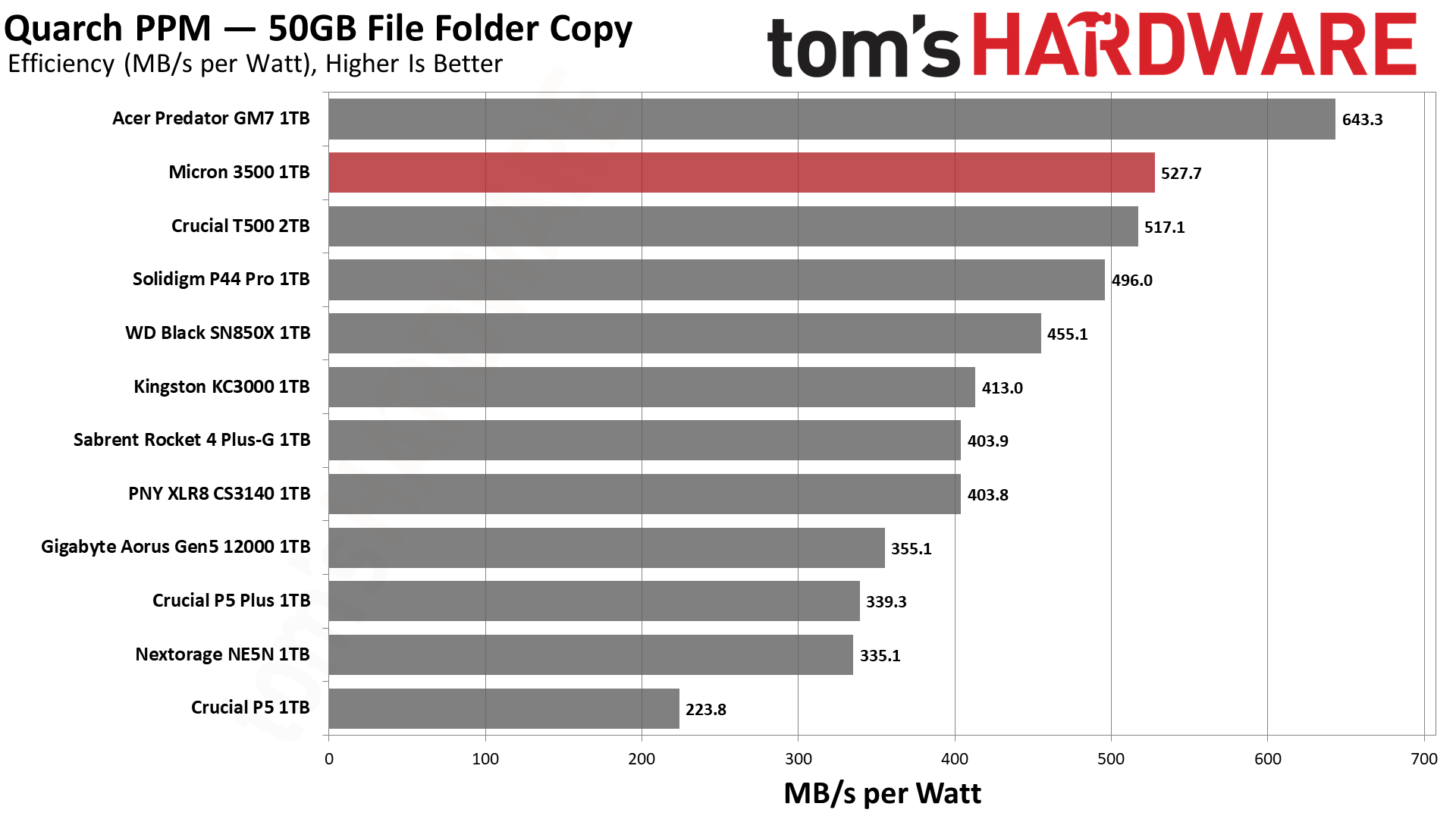
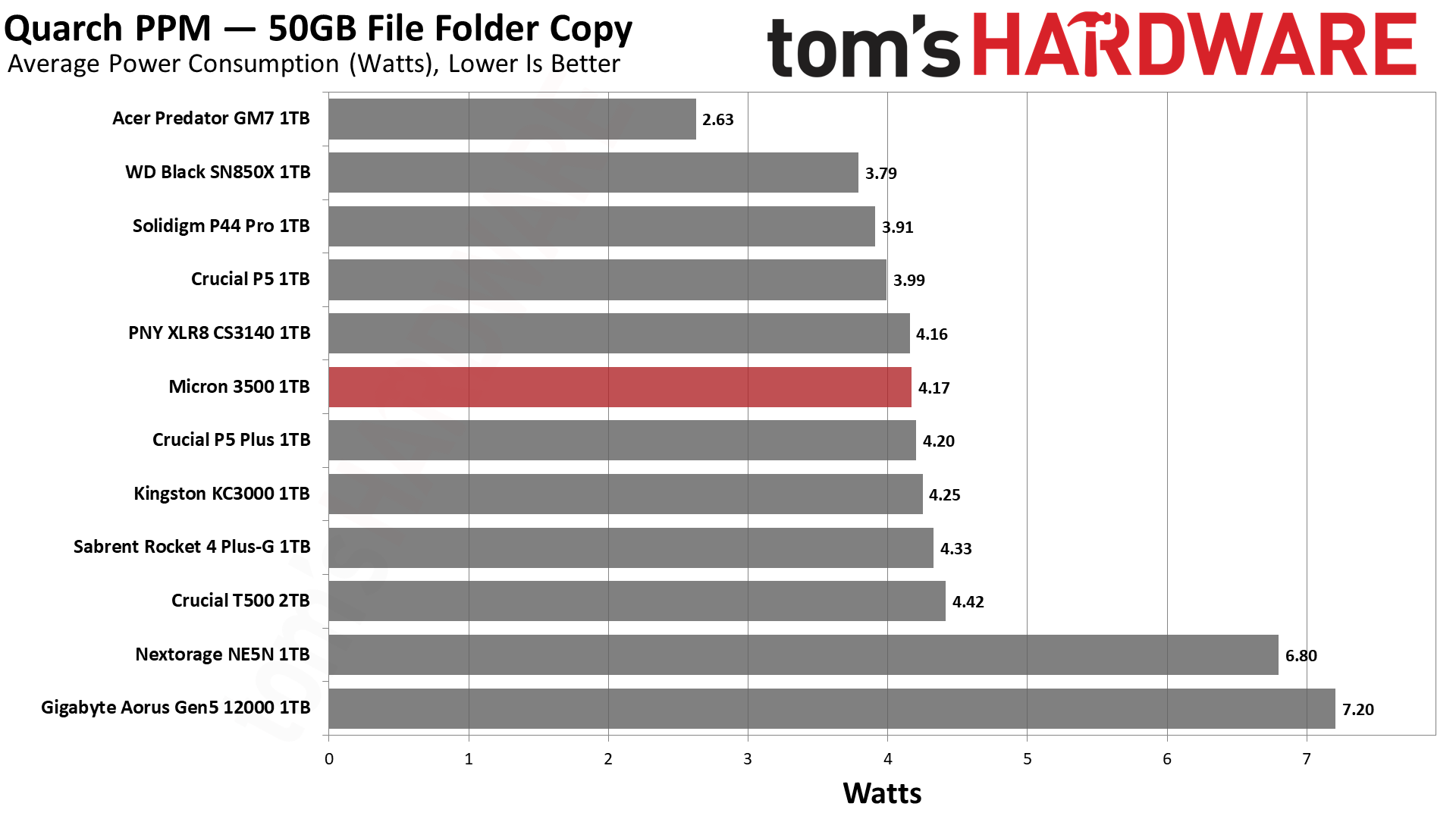


The Micron 3500 is quite power efficient, even more so than the 2TB T500. This is an improvement over almost all existing PCIe 4.0 drives, although newer DRAM-less models — like the GM7 or NM790 — are better yet. We are happy to see that the E25 SSD controller doesn't have the same issues as the enterprise-inspired E26. This means the 3500 can work in so-called ultrabooks from both a power and performance perspective, as the drive is designed with Intel's Project Athena in mind.
Let's deviate a bit and talk about the power specifications. Micron officially rates the 3500 at <5mW for sleep, <400mW for active idle, and <8.25W for maximum load. The two throttle states — which by SMART are at 86°C and 88°C — choke the drive to 4.0W in PS1 and 2.2W in PS2. These numbers compare to 3.5mW, 25mW, 3W, 4W, and 8.25W by SMART, which lines up with Phison's E25 numbers. 8.25W max is quite a lot, and in fact we only hit a maximum 5.64W in our testing, which is higher than the popular Maxio drives. The 3500 is still an excellent choice for laptop use, though we suspect the DRAM-less E27T controller may prove to be even better.
Our temperature testing confirms the 3500's portable viability as we only saw a maximum temperature of 43°C — that's with the heatsink version in a case with plenty of airflow. This is well below the throttling temperatures and also within the 0°C-70°C operating rating. Power is usually tested with an assumed 25°C ambient and the operating temperature, TC, is measured in part by the case temperature. In other words, the Micron 3500 drive and drive components can hit very high temperatures without necessarily breaching any thermal limits. The 3500 with a heatsink should be fine in any machine or the PS5, as is and without additional cooling.
Test Bench and Testing Notes
| CPU | Intel Core i9-12900K |
| Motherboard | Asus ROG Maximus Z790 Hero |
| Memory | 2x16GB G.Skill DDR5-5600 CL28 |
| Graphics | Intel Iris Xe UHD Graphics 770 |
| CPU Cooling | Enermax Aquafusion 240 |
| Case | Cooler Master TD500 Mesh V2 |
| Power Supply | Cooler Master V850 i Gold |
| OS Storage | Sabrent Rocket 4 Plus-G 2TB |
| Operating System | Windows 11 Pro |
We use an Alder Lake platform with most background applications such as indexing, Windows updates, and anti-virus disabled in the OS to reduce run-to-run variability. Unless noted, we use active cooling for all SSDs — meaning, a fan directs airflow toward the SSD.
Bottom Line
We were destined to give the Micron 3500 the same score as the Crucial T500 from the start. These are, for all intents and purposes, the same drive, after all. Performance is mostly comparable and performance at 1TB is as good or better than expected in comparison to 2TB, which we're happy to see, though caution is warranted for 512GB model.
While there are shades of firmware tweaks in the 3500, sustained performance remains a weak area. This is working as intended — after all, a large cache is desirable for consumer workloads — but the lengthy folding period is a fact that should not be ignored. Micron and Phison will likely work to shore up any deficiencies.
Power efficiency is quite good, which we certainly like to see for client drives and for laptop-friendly drives as well. You can get top tier PCIe 4.0 performance without any real drawbacks. It's true that the Maxio MAP1602 and YMTC beat Phison and Micron to the punch on this front, but the former is a DRAM-less solution. Phison's own DRAM-less design, the upcoming E27T, as well as SMI's SM2268XT, will surely be a potent match when paired with Micron's 232-Layer flash. The T500 is a demonstration of what the hardware can do, taking it a step forward by designing it as a reliable client SSD in the Micron 3500.
If you're doing more than looking at machines and intend to buy a Micron 3500 on the secondary market, for whatever reason, our conclusions for the T500 still apply. Heavier workloads may benefit from characteristics of E18- and IG5236-SSDs that have been around a lot longer. If you really want 4TB, there are also many alternatives, both with TLC and QLC. For maximum performance and for fast file transfers, PCIe 5.0 drives are not out of the question. Otherwise, the 3500 is a top pick if it can be found at the right price. You're more likely to find it in a newly-built system, in which case we have little bad to say about, especially as it will beat the Kioxia BG6.
With the rise in popularity of portable gaming systems like Valve's Steam Deck/Deck OLED and the Asus ROG Ally, you might be more interested in OEM or client drives with an M.2 2230 form factor option. The BG6 could certainly deliver there, but there are plenty of retail options available now. Many portable systems also take M.2 2280 and with the stock storage capacity increases, the appeal of 4TB single-sided drives also increases. We will see this for the T500 but not the 3500. It's easy enough to say that this drive doesn't offer a lot in that space unless you really want DRAM.
We're definitely eager to see what Crucial has lined up for next year and look forward to testing more of its drives, client or otherwise, in 2024. We think the T500 has been a hit, and the Micron 3500 pushes the performance envelope for a client drive. Crucial has also done a great job of pricing its most popular drives to stay competitive and we hope a lot of OEM builders take a shine to the 3500. You can't go wrong with either drive.
MORE: Best Hard Drives
MORE: Best SSDs
MORE: How We Test HDDs And SSDs

Shane Downing is a Freelance Reviewer for Tom’s Hardware US, covering consumer storage hardware.
